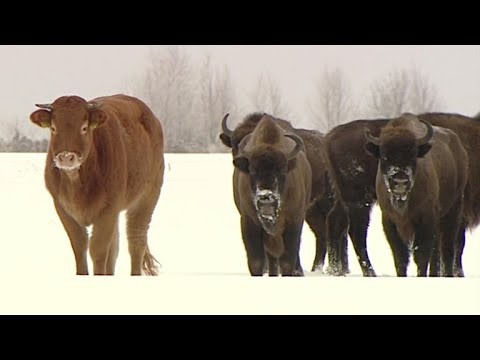Grazing Lands Carbon Cycle Research and Education

HISTORICAL BISON HERDS PRODUCED METHANE COMPARABLE TO CATTLE IN THE GREAT PLAINS
By Rebecca L. Phillips, Ph.D. & Jerry Doane, North Dakota Grazing Lands Coalition
Lucy Britton, Michael Bush and Meghan Carter, Audubon Dakota
May 29, 2020
Methane emissions by cattle in the Great Plains, while substantive, are comparable to historical bison emissions. These results were published by Kelliher and Clark in the journal Agricultural and Forest Meteorology. Results beg the question of whether ruminant methane is a contemporary environmental issue or a natural part of the grazing land ecosystem. In this article, we discuss how emissions of methane from ruminant grazing animals (such as bison, cattle, sheep, or deer) is integral to the recycling and conservation of carbon from air, into plants, then animals, and back into grassland soils.

Ruminant grazing animals can acquire nutrients from grasses by fermenting them in a specialized stomach, called a rumen. Microbes in the rumen produce enzymes that break down plant material in the absence of oxygen and produce methane as a fermentation by-product. Ruminants are unique in their capacity to extract energy from grassland plants. This conversion cannot occur without removing hydrogen gas through reaction with carbon to form methane. Methane is common wherever fermentation occurs; landfills emit more methane per unit area than any other single source. Here, we focus on ruminant methane because some suggest that elimination of ruminants like cattle will solve the climate change problem. However, ruminants over geological time emitted methane. Can we really single out cattle as the problem? Aren’t grazers just one component to the grassland ecosystem?
Prior to European settlement, the 10-state region of the Great Plains (2.9 million square kilometers) was inhabited by 30 million ruminant bison. The historical bison herd met their energy requirements through enteric fermentation, which released 2.2 million metric tons of methane per year, or 11 pounds of carbon as methane per acre per year over the Great Plains region. Today, bison grazers in the Great Plains have largely been replaced by 40 million ruminant cattle. These cattle meet their energy requirements through enteric fermentation, which releases 2.5 million metric tons of methane per year, or 13 pounds of carbon as methane per acre per year. This historical context is important as we try to understand the role cattle play in current debates about methane.

Methane, like carbon dioxide (CO2), is a carbon-based molecule. Carbon is the backbone of the food web that moves through organisms in various molecular forms and states. The figure at left illustrates how gaseous carbon is removed from the atmosphere by plants and transferred to soils through roots or herbivores through grazing. The metabolism of carbon compounds is not 100% efficient. Some carbon in plants, soils or grazers is returned the atmosphere as carbon dioxide or methane. Grassland plants take more carbon from the atmosphere than they use for aboveground growth—some of which is stored as soil organic matter. Storage of carbon in soil as organic matter is commonly referred to as carbon sequestration. Long-term studies by the National Aeronautics & Space Administration and the U.S. Geological Survey report that grasslands of the Great Plains conservatively sequester an average of 24 tons per square kilometer per year (Zhang et al 2011) or 220 pounds per acre. This amount of carbon stored greatly exceeds the amount of carbon emanating from the rumen in cattle (see bison discussion above), which is one reason ruminant methane cannot be fully evaluated as an isolated factor independent of the ecosystem. Grazers co-adapted with grassland species over time, and different forms of carbon (including methane) move through the entire ecosystem to serve energy and habitat requirements for its multiple inhabitants. Greater rates of soil carbon sequestration can be achieved through regenerative practices, such as adaptive grazing management (http://www.fao.org/3/x5304e/x5304e03.htm; https://www.drawdown.org/).
So, what is the connection between carbon and methane in grasslands? Ruminant grazers co-adapted with grasslands to optimize the use of carbon as it moves through the ecosystem. Some of the carbon in plants must be released as methane in the process of converting plant material to energy in the rumen. The carbon stored belowground in grazing lands dwarfs the carbon lost as methane. We summarize with three key points: 1) all ruminants produce methane; historically, bison emissions were comparable to cattle emissions today, 2) amounts of carbon stored as organic matter in Great Plains grasslands exceed amounts emitted as methane , and 3) ruminants indirectly improve grassland soils over time by participating in the process of building soil organic matter.
